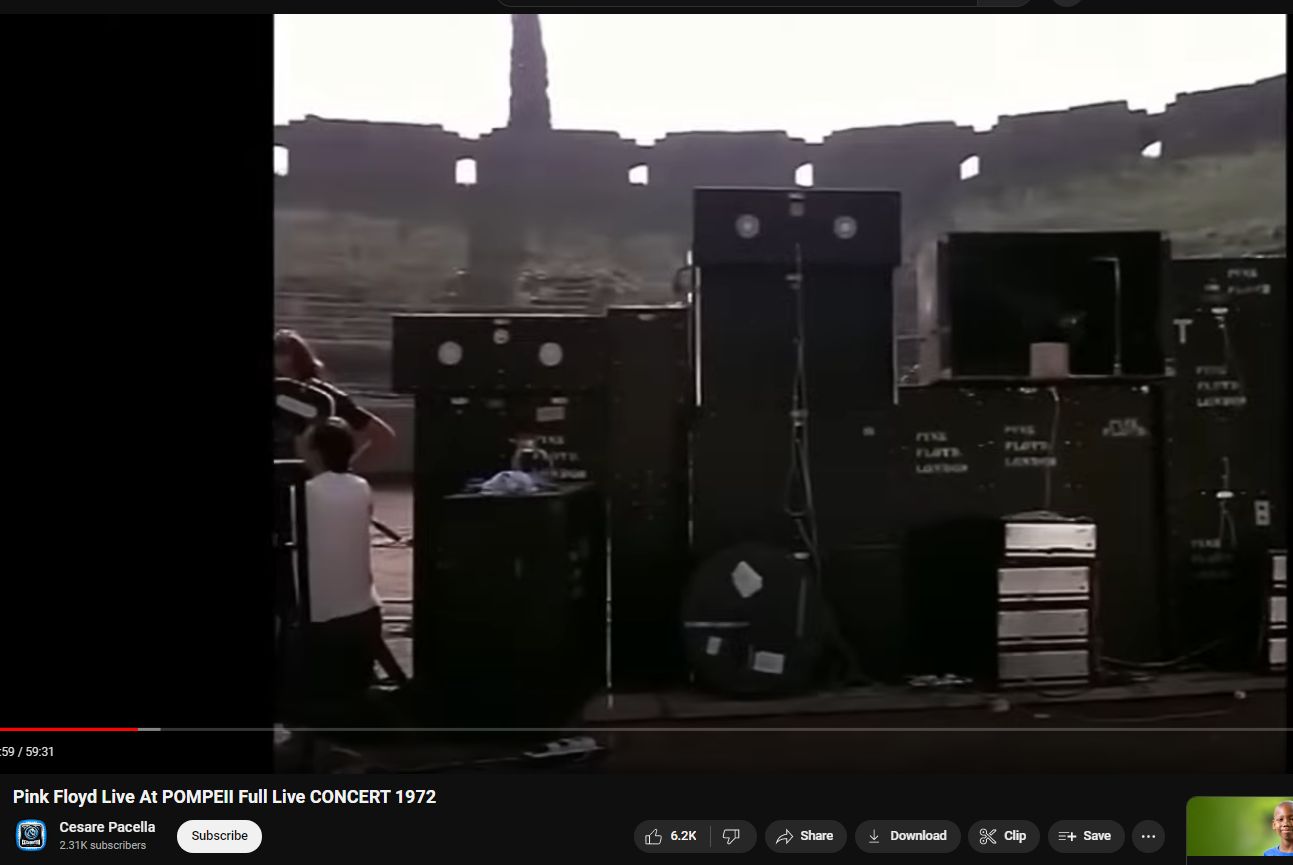What was the purpose of this? Merely to do something relatively ‘new’?
It is curious the first item brought in was the gong; accompanied by gong bong sound as intro.
Along with orange scent, gong sound almost uniformly sends EEG brain wave measurements off-chart high.

Comments:
“This has to be one of those very rare seminal moments in the history of music.”
“I just didnt get pink floyd until I watched this on VHS and it all made sense.”
“I was at Pompeii, this music fits so nicely to the environment over there, it’s ghostly and probably how human life ends.”
“Playing in an ancient amphitheater is both Spinal Tap-ish and absolutely awesome.”
“The moment [batter, er drummer] Nick Mason got tinnitus.”

Resonance in Stone: Pink Floyd’s Pompeii Amphitheater Performance
Pink Floyd, a legendary band known for their groundbreaking music and immersive performances, achieved a unique and unforgettable experience with their iconic concert at the Pompeii amphitheater. This historic event not only showcased the band’s musical prowess but also tapped into the natural resonance of the ancient stone structure, enhanced by the piezoelectric effect and amphitheater acoustics. In this blog post, we delve into the mesmerizing synergy of Pink Floyd’s music and the energetic qualities of the Pompeii amphitheater.
Setting the Stage: Pompeii Amphitheater
The Pompeii amphitheater, an ancient Roman structure nestled in the heart of Italy, served as the backdrop for Pink Floyd’s performance in 1971. Built from volcanic rock, the amphitheater’s stone construction possesses unique acoustic properties, characterized by its ability to resonate and amplify sound waves.
The Piezoelectric Effect: Amplifying Energy
The stone used in the construction of the Pompeii amphitheater, primarily composed of limestone and volcanic rock, exhibits piezoelectric properties. This means that when subjected to mechanical stress, such as vibrations from sound waves, the stone can generate electric charges. The piezoelectric effect, coupled with the inherent resonance of the stone, creates an energetically charged environment that amplifies the acoustic experience within the amphitheater.
Pink Floyd’s Performance: A Symphony of Resonanc
As Pink Floyd took the stage in the ancient amphitheater, their music reverberated through the stone structure, creating a symphony of resonance. The band’s experimental soundscapes, ethereal melodies, and dynamic compositions intertwined with the natural acoustics of the amphitheater, producing a transcendent auditory experience for both the band and the audience.
https://soundquality.org/wp-content/uploads/2024/04/dogmonica.jpg
Amplified Emotions: The Power of Place
The combination of Pink Floyd’s music and the Pompeii amphitheater’s energetic properties elicited amplified emotions and heightened sensory experiences. The immersive quality of the performance, enhanced by the stone’s piezoelectric effect and acoustics, immersed the audience in a sonic journey that transcended time and space.
Legacy of Resonance
Pink Floyd’s performance at the Pompeii amphitheater remains a testament to the power of resonance and the harmonious interplay between music and environment. It serves as a reminder of the profound impact of place on artistic expression and the potential for synergy between human creativity and natural energies.
In conclusion, Pink Floyd’s legendary concert in the Pompeii amphitheater stands as a testament to the transformative potential of music and the harmonious resonance between sound, space, and stone. It exemplifies the timeless connection between art, environment, and the universal language of music that transcends boundaries and resonates with audiences across generations.

There is some ill intention here, can’t quite put my finger on it. That sense permeates for me all things Pink Floyd. The drugs. The disconnecting. Something not right, never been right.
